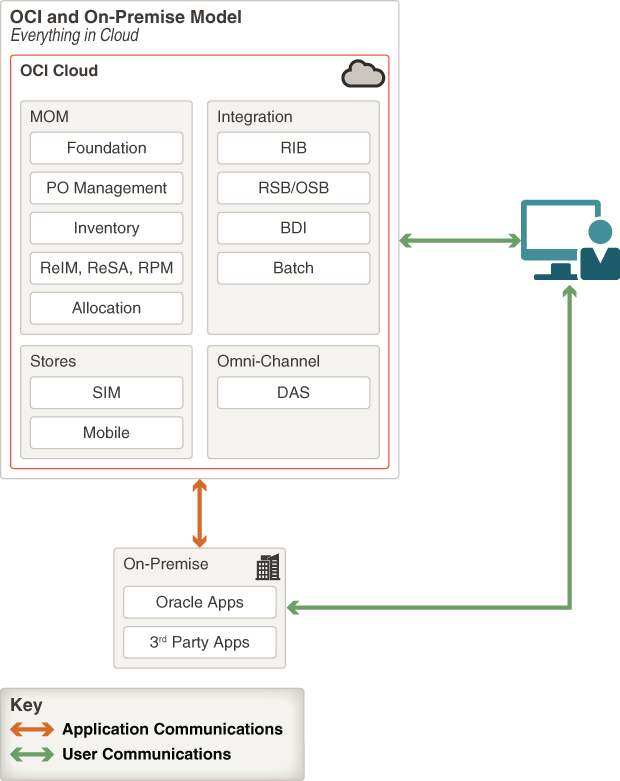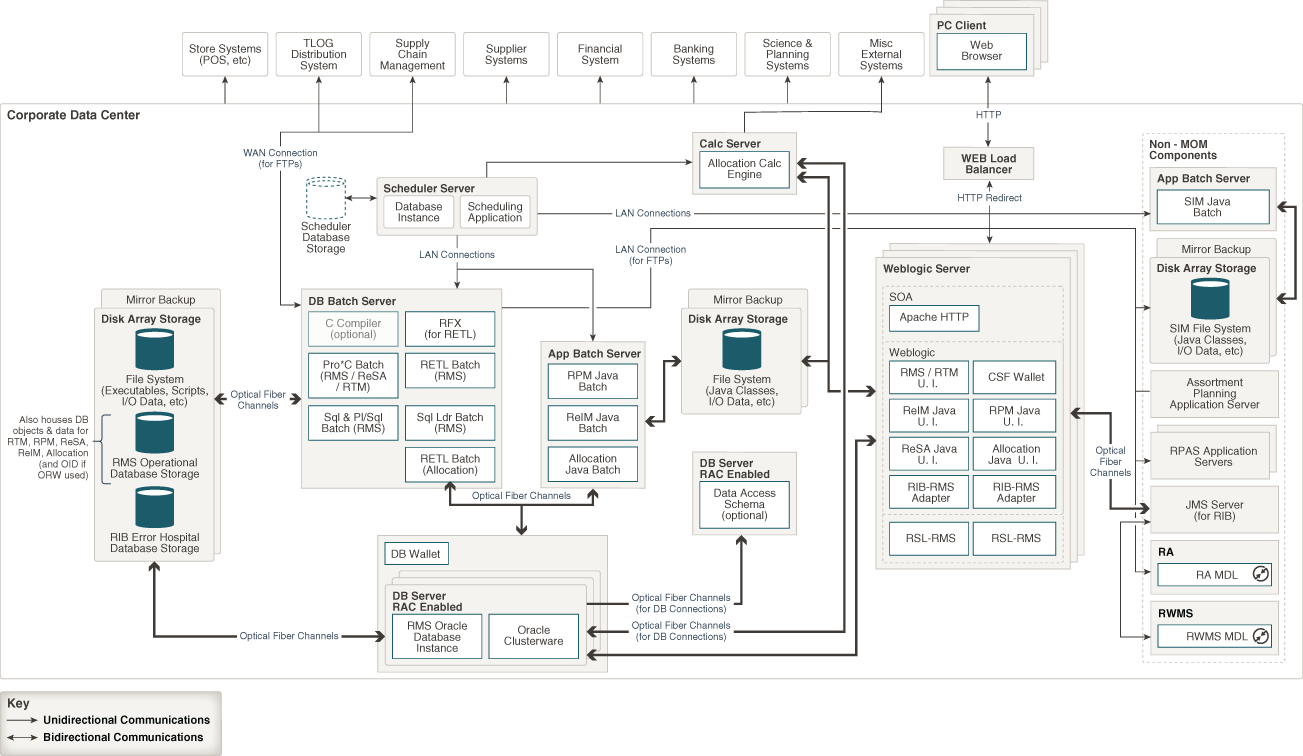Learn About Architecting Retail Applications on Oracle Cloud
Oracle Retail Merchandising System on Oracle Cloud provides provides a number of architecture configurations to match your current on-premises design. With the its built-in Lift and Shift capability, moving from on-premises, operational risk has been reduced with improved success on all migrations. Oracle Cloud is also very cost-effective for rapid deployment and removal of test and QA environments.
Before You Begin
This solution will provide you with background on the available implementation methods for various Oracle Retail Merchandising Suite configurations, and the Oracle Cloud-Oracle Retail Merchandising System architecture for initial development and test as well as production deployment. This includes all the necessary compute instances, storage, security, networking and connectivity. 
Description of the illustration oci_on-prem_model.png
This is a design solution and is not intended to provide a production deployment reference architecture. Instead, it's a high-level reference guide for deploying Oracle Retail Merchandising System applications by either moving an environment from on-premises—lift and shift—to the cloud or creating a new environment on Oracle Cloud. This solution outlines some of the best practices and should not be viewed as a full reference guide for Oracle Retail Merchandising System.
Architecture
This architecture shows how you can implement Oracle Retail Merchandising Suite on Oracle Cloud.
The physical architectural model, below, will ensure clarity and assist you in associating Oracle Cloud reference architecture design examples. 
Description of the illustration rms_oci_physical_model.png
Learn About Oracle Retail Merchandising System
Oracle Retail Merchandising System allows you to manage, control, and perform seamless execution of day-to-day merchandising activities, including purchasing, distribution, order fulfillment, and financial close.
- Retail Invoice Matching (ReIM)
- Retail Price Management (RPM)
- Retail Trade Management (RTM)
- Retail Sales Audit (ReSA)
- Retail Allocation (RA)
- Retail Integration Bus (RIB)
- Bulk Data Integration (BDI)
- Retail Store Inventory Management (SIM)
- Business Intelligence Publisher (OBI PuB)
- Identity Management (IDM)
Learn About Oracle Retail Merchandising System on Oracle Cloud
Think of Oracle Retail Merchandising System on Oracle Cloud as running exactly you run the same topology on premises in your data center today—the same applications you may have customized—on a combination of Oracle’s Infrastructure as a Service (IaaS) and Platform as a Service (PaaS).
- Infrastructure as a Service: Oracle Cloud Infrastructure is a set of complementary cloud services that enable you to build and run a wide range of applications and services in a highly-available hosted environment. Oracle Cloud Infrastructure offers high-performance compute capabilities and storage capacity in a flexible overlay virtual network that is securely accessible from your on-premises network. OCI provides highly scalable, competitively priced compute capacity that you can use to host your Oracle Retail RMS application tier and, optionally, your database tier.
- Infrastructure as a Service + Platform as a Service: Oracle Cloud Platform is a comprehensive, standards-based, fully integrated combination of Oracle and open source technologies you can use to build, deploy, migrate, and manage a variety of different application workloads in the cloud at a significantly lower operational cost. The OCI DB System or OCI Exadata DB System can be used to run your database tier, enabling you to provision your chosen database configuration quickly and easily.
About Platforms Supported by Oracle Retail Merchandising Suite on Oracle Cloud
Oracle Retail Merchandising System supports the following platforms, storage, networking and versions on Oracle Cloud:
-
Oracle Retail Merchandising System Release v16
-
Oracle Retail Merchandising System Application Tier
- Operating system versions:
- Oracle Linux (6.x, 7.x)
- RedHat Enterprise Linux (6.x, 7.x)
- Application Technology Stack
- Oracle ADF - 12.2.1
- OID - 11.1.1.9
- OAM/WebGate - 11.1.2.3
- Oracle HTTP server - 12.2.1
- Oracle BI Publisher - 12.2.1
- Oracle MAF - 2.2
- Browsers Support - Chrome 48+, IE 11+, Firefox ESR 45+
- OCI Deployment Options
- Compute VM
- Single node
- Multiple nodes with Load Balancer as a Service (LBaaS)
- Compute VM
- Operating system versions:
- Oracle Retail Merchandising System Database Tier
- Operating system versions: Oracle Linux (6.x, 7.x)
- RedHat Enterprise Linux (6.x, 7.x)
- Database versions: Oracle Database 12.1.0.2 or greater with Partitioning
- OCI Deployment Options
- Compute (VM): Single node with Database Enterprise Edition
- Database as a Service (DBaaS)
- Single Instance (VM) with Enterprise Edition (EE), High Performance (EE-HP)
- 2-node RAC Instance (VM) with Extreme Performance (EE-EP)
- Exadata DB System: Real Application Clusters (RAC) and many additional advanced features
- Available storage options for Oracle Retail Merchandising System on OCI
- Database storage uses high-performance local or network NVMe block storage
- Object storage is used as the target for database backups
- A separate NFS server or File Storage Service (FSS) may be used for the Oracle Retail Merchandising System shared application tier file system
-
Network architecture with multiple configurations are available in support of the Oracle Retail Merchandising System environment
- Custom network definition
- Configure both Application and DB servers with your own subnet ip ranges (CIDR)
- LBaaS will have Public IP for external connectivity
- Load Balancer
- LBaaS external Public IPs
- LBaaS supports both Public and Private load balancing
- Hybrid Story for migration, connectivity and integration with on-premises
- VPN Connectivity
- VPN IPSec Tunneling
- MPLS / Fast Connect
- Custom network definition
About Security and Compliance Recommendations
Oracle recommends that you use of Oracle Cloud Security Lists and Security Rules with Oracle Retail Merchandising System.
With the use of Security Lists and Security communication of the protocols and ports are limited to allow only the traffic that is needed for the application to function properly. When using the automated Lift and Shift, a number of Security Lists (SL) are created that are dependent on your initial network entries. Lift and Shift creates multiple Security Lists as these are dependent on which tier or component is deployed. For example, during deployment you might create Security Lists for the application tier, database tier and load balancer. The configuration process is repeated for the Routing tables as well.
Note:
Oracle Retail Merchandising System does not handle any HIPPA and PCI information.- General: SOC1, SOC2, ISO 27001/2
- Specific: PCI, HIPAA, NIST 800-53